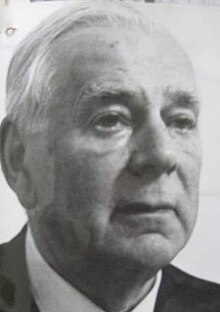Herman Rosse
Hermann Rosse | |
|---|---|
 | |
| Born | 1 January 1887 The Hague, Netherlands |
| Died | 13 April 1965 (aged 78) Nyack, New York, U.S. |
| Occupations |
|
| Years active | 1909-1960 |
Hermann Rosse (1 January 1887 – 13 April 1965) was a Dutch-American architect, illustrator, painter, theatrical designer, and art director.[1] He won an Academy Award for Best Art Direction for the film the King of Jazz.[2]
Early life
He was born in The Hague, Netherlands, and died in Nyack, New York. Herman was the second child of Carl Rosse (8 March 1857 at Kassevitz - ?) and Jacoba, Susanna de Haan. The elder sister of Herman, Bertha, Suzanna (SUZE) Rosse (The Hague, 1 September 1884 – 17 April 1968) became a well-known Dutch painter.
Career
Hermann Rosse studied at the Academy of Art in
In 1918, he moved to Illinois, where he accepted an appointment to head the Design Department of the School at the
Rosse worked in theatre in London and the Netherlands, taught as the Professor of Decorative Art at the Technische Hoogeschool in Delft, and designed Dutch pavilions at world's fairs in Brussels, Paris, and New York. He also created plans for subdivisions in several Dutch cities. In 1948 Rosse was appointed Resident Stage designer at the
Since 1988 members of the Rosse family have donated books, manuscripts, paintings, drawings, prints, plans, photographs, documents, and memorabilia concerning the work of Herman and Helena Rosse to Chapin Library, Williams College Williamstown, Massachusetts (USA).
Filmography
- The Emperor Jones (1933)
- Strictly Dishonorable (1931)
- Resurrection (1931)
- Frankenstein (1931)
- East Is West (1930)
- King of Jazz (1930)
- Oriente y occidente (1930)
References
- ^ Scheen, Pieter A. (1970). Lexicon Nederlandse beeldende kunstenaars, 1750-1950, vol.2. The Hague, Netherlands: s'Gravenhage. pp. 261–262.
- ^ New York Times, 15 April 1965, p. 34.
- ^ The National Cyclopedia of American Biography, Vol.51. New York, NY: James T. White & Co. 1966. p. 419.
- ^ ISBN 9781467545679. An online facsimile of the entire text of Vol. 1 is posted on the Traditional Fine Arts Organization website ("Jennie V. Cannon: The Untold History of the Carmel and Berkeley Art Colonies, vol. One, East Bay Heritage Project, Oakland, 2012; by Robert W. Edwards". Archived from the originalon 29 April 2016. Retrieved 7 June 2016.).
- ^ New York Times, 20 February 1921, p. 7.
- ^ San Francisco Chronicle, 11 January 1914, p.20.
- ^ San Francisco Chronicle: 5 December 1915, p.24; 20 February 1916, p.24.
- ^ The Oakland Tribune: 28 January 1916, p.5; 11 June 1916, p.13; 2 December 1917, p.21; 12 May 1918, p.24.
- ^ The Wasp (weekly, San Francisco, CA): 24 June 1916, p.10; 23 September 1916, p.14; 8 December 1917, p.15; 11 May 1918, p.16.
- ^ The Oakland Tribune: 17 June 1917, p.24; 1 September 1918, p.6.
- ^ American Art Annual: 16, 1919, p.487; 18, 1921, p.549.
- ^ The Oakland Tribune, 19 October 1919, p. S-5.
- ^ New York Times: 20 February 1921, p. 7; 27 February 1921, p.BR-11.
- ^ Theatre Arts Monthly, 16, 1932, pp. 467-470.
External links
- Herman Rosse at IMDb
